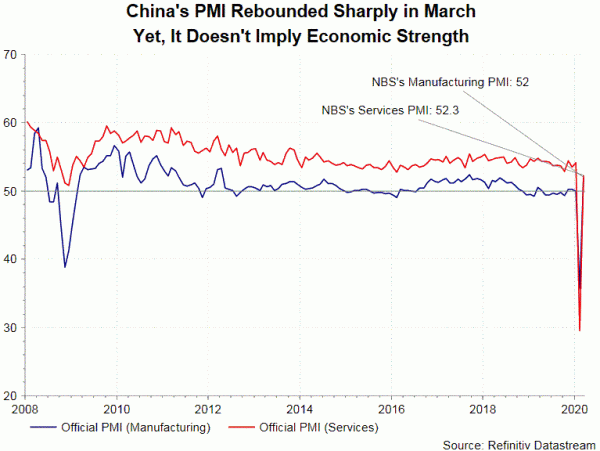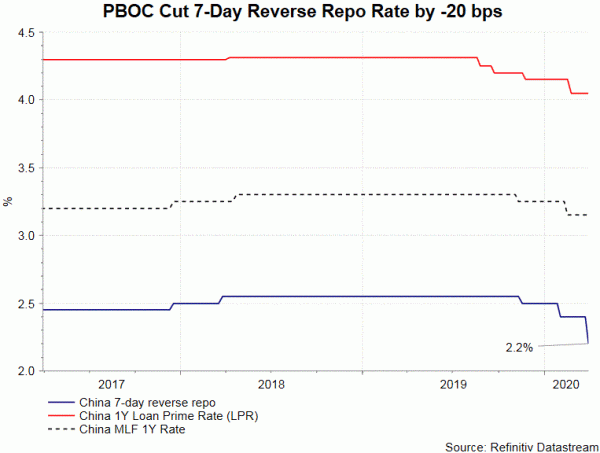China’s official PMIs sharply rebounded in March. Manufacturing PMI jumped to 52, from a record low of 35.7 in February. The non-manufacturing index rose to 52.3, from a record low of 29.6 in February. We suggest to interpret the data with caution as the qualitative nature of the survey might have masked the actual situation of economic activities. Indeed, as the coronavirus outbreak, first started in Wuhan city in China, has evolved into global pandemic, the impacts on Chinese economy are not limited to shrinking domestic demand, but also collapse in global demand and global supply chain disruption. We expect the government to accelerate monetary and fiscal stimulus in coming months in order to contain the crisis.
Three out of the five components comprised of the manufacturing PMI rose above 50, above which the activities are in expansion. Production sub-index gained +26.3 points to 54.1, new orders sub-index rose +22.7 points to 52 and employment sub-index added +19.1 points to 50.9. While showing improvement, raw material inventory sub-index and supplier delivery time sub-index stayed in the contractionary territory. Concerning other indices related to the manufacturing sector, new exports order worsened to 47.1 in March from 49.2 a month ago, while imports dropped -1 point to 48.7. These suggested that international trade situation weakened in March.
Concerning non-manufacturing activities, the sub-indices on business activities, new orders, input price and output price were above the 50 benchmark. All but input price sub-index recovered from February. Meanwhile, the employment sub-index stayed unchanged at 48.7. Other indices related to the non-manufacturing sector failed to impress. Despite recovering from February, new orders, existing orders and inventory all stayed below 50, signaling contraction.
Despite strong headline readings, the sub-indices in both manufacturing and non-manufacturing PMIs suggest that China’s economic activities continue to struggle. Meanwhile, one should note that PMI surveys are qualitative in nature. Purchasing manages interviewed are asked “whether activities improved compared with the previous month”. The strong readings in March likely reflect better impression of economic activities in March when compared with February, rather than actual recovery.
PBOC surprisingly cut the 7-day reverse repo rate, by -20 bps, to 2.2% in a RMB 50B operation on Monday. The move was following Chinese Communist Party’s Politburo meeting last week. The Party leaders called for acceleration in both monetary and fiscal stimulus to ensure growth stability. The rate cut was the largest since 2015. We expect PBOC to lower MLF rate and LPR rate by the same amount in coming two weeks.
On the fiscal front, the meeting last week talked about issuance of central government special bonds. Such tool was rarely used, only in 1998 and 2007, signaling the severity of the current crisis. Besides, the government called for more aggressive fiscal spending. We expect the fiscal deficit could reach around 3.5% of GDP this year, although policymakers stick to the 3% target.















